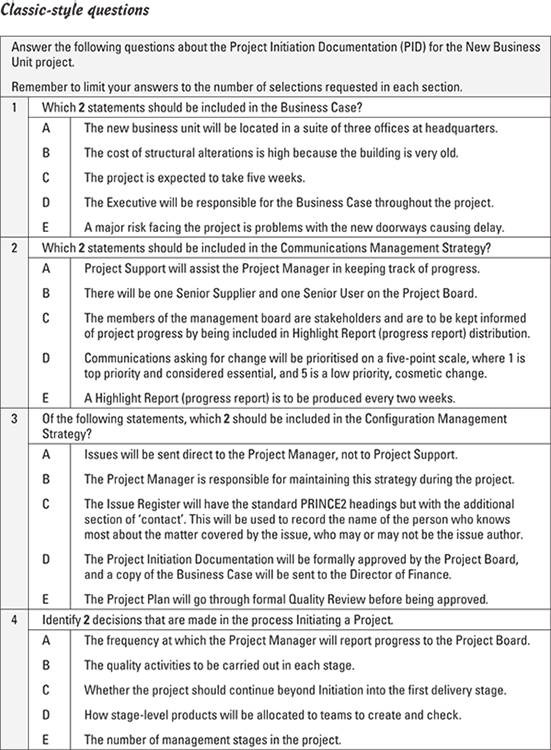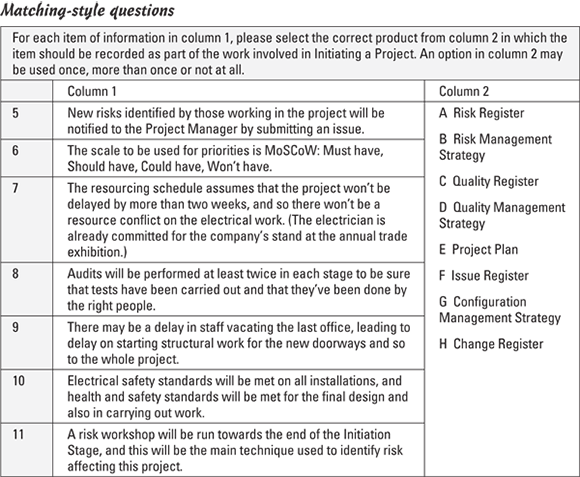Practising With Some Questions
On the following pages, you’ll find some questions based on the Initiating a Project process. The answers are on the grey-edged pages at the end of the chapter.
Foundation-level questions
You’ll find answers to these questions, and some explanation, at the end of the chapter. Set your timer for eight minutes then go for it.
1. Which of the following does NOT form part of the Project Initiation Documentation (PID)?
![]() a) Business Case
a) Business Case
![]() b) Project Plan
b) Project Plan
![]() c) Risk Management Strategy
c) Risk Management Strategy
![]() d) Stage Plan for the first delivery stage (the stage after the Initiation Stage)
d) Stage Plan for the first delivery stage (the stage after the Initiation Stage)
2. Which of the following strategies defines how change control will be carried out?
![]() a) Risk Management Strategy
a) Risk Management Strategy
![]() b) Quality Management Strategy
b) Quality Management Strategy
![]() c) Configuration Management Strategy
c) Configuration Management Strategy
![]() d) Communication Management Strategy
d) Communication Management Strategy
3. Which of the following is an accurate definition of a stakeholder in PRINCE2?
![]() a) Someone who’s a member of the project’s Project Board
a) Someone who’s a member of the project’s Project Board
![]() b) Someone who can affect, or be affected by, the project
b) Someone who can affect, or be affected by, the project
![]() c) Someone with financial responsibility for the project
c) Someone with financial responsibility for the project
![]() d) Someone who’s responsible for the delivery of business benefits
d) Someone who’s responsible for the delivery of business benefits
4. Which of the following is used in PRINCE2 to record when business benefits will be measured?
![]() a) Benefits Register
a) Benefits Register
![]() b) Business Case
b) Business Case
![]() c) Benefits Review Plan
c) Benefits Review Plan
![]() d) Project Cashflow
d) Project Cashflow
5. Which of the following options names plans which are created in the process Initiating a Project?
![]() a) Project Plan and Benefits Review Plan
a) Project Plan and Benefits Review Plan
![]() b) Project Plan together with all Stage Plans
b) Project Plan together with all Stage Plans
![]() c) Project Plan and Business Plan
c) Project Plan and Business Plan
![]() d) Benefits Review Plan and Team Plan
d) Benefits Review Plan and Team Plan
6. Which of the following does PRINCE2 include as a section in the full Business Case?
![]() a) Benefits Review Plan
a) Benefits Review Plan
![]() b) Benefits Realization Schedule
b) Benefits Realization Schedule
![]() c) Investment appraisal
c) Investment appraisal
![]() d) Cost–benefit analysis
d) Cost–benefit analysis
7. Which role is responsible for producing the Project Initiation Documentation (PID)?
![]() a) Executive
a) Executive
![]() b) Senior User
b) Senior User
![]() c) Sponsor
c) Sponsor
![]() d) Project Manager
d) Project Manager
8. Which of the following phrases is part of the purpose statement for the process Initiating a Project?
![]() a) To establish a clear organisation structure for the project
a) To establish a clear organisation structure for the project
![]() b) To produce a Stage Plan for each delivery stage to determine total costs
b) To produce a Stage Plan for each delivery stage to determine total costs
![]() c) To ensure that all risks in the project have been identified and their management planned
c) To ensure that all risks in the project have been identified and their management planned
![]() d) To establish solid foundations for the project
d) To establish solid foundations for the project
9. Which of the following is NOT used as an input to the activity Prepare the Risk Management Strategy?
![]() a) Project Mandate
a) Project Mandate
![]() b) Project Brief
b) Project Brief
![]() c) Lessons Log
c) Lessons Log
![]() d) Daily Log
d) Daily Log
10. Which of the following products are created in the process Initiating a Project?
A. Risk Register
B. Issue Register
C. Project Plan
D. Project Product Description
![]() a) A, B and C
a) A, B and C
![]() b) A, B and D
b) A, B and D
![]() c) A, C and D
c) A, C and D
![]() d) B, C and D
d) B, C and D
Practitioner-level questions
There’s no additional scenario information for these questions. However, don’t forget to keep in mind, where you need it, the original scenario information, which you’ll find at the end of Chapter 2.
To read some advice on dealing with the different styles of Practitioner question, please also see Chapter 2.
Set your timer to 18 minutes, but if you can answer accurately in slightly less time, then that’s good. In the exam you’ll have 10 questions in a section, about 15 minutes to answer them and the section will cover Start Up as well as Initiation. This part of the chapter gives you a generous 12 questions – hence the 18 minutes – and just on the process Initiating a Project, so you’ve got lots to practise with.



Answers to the Foundation-level questions
1. d. Stage Plan for the first delivery stage. The Business Case, Project Plan and Risk Management Strategy are included in the PID. [Manual A.20.2]. The Stage Plan is separate, because it’s not ‘whole project’ – there are usually a series of Stage Plans, because most projects are multi-stage – and the Project Initiation Documentation (PID) covers the whole project.
2. c. The Configuration Management Strategy is badly named, because the name leads you to think it covers just Configuration Management. In fact, the strategy also covers issue handling and change control. Configuration management is, of course, closely coupled with change control, but they’re not the same thing.
3. b. You’ll find some definitions in the glossary of the manual, and this is worth a look through when you’re revising. In this case, the glossary helps because the main body of the manual introduces confusion where it talks of stakeholder engagement but doesn’t first make a clear distinction between stakeholders within the project and those outside it. As with much of the 2009 manual, if you already understand the method you can make sense of the text, but if you don’t know the method you can become very confused.
4. c. Some questions are easier to answer if you look carefully at the exact words. Here the word ‘plan’ within the name ‘Benefits Review Plan’ hints at the answer, even if you didn’t already know.
5. a. A Stage Plan is created on the stage boundary, just before that stage begins. Stage Plans are not created en bloc for the whole project during Initiation. There’s no such thing as a Business Plan in PRINCE2. When needed, a Team Plan is created when a Work Package (assignment) is received by a Team Manager during a delivery stage, not during Initiation.
6. c. The Benefits Review Plan is a separate product. There’s no such thing as a Benefits Realization Schedule in PRINCE2, and cost–benefit analysis is a technique, not a heading in the Business Case. ‘Investment appraisal’ is a heading in the PRINCE2 Business Case. [Manual A.2.2, P2FD Ch11 Writing a Business Case]
7. d. The Project Manager consults others while producing the PID, but is responsible for it.
8. d. Sadly, there’s no short cut here. You need to be familiar enough with the purpose statements to be able to recognise what is a part of a statement and what isn’t. The trouble is that the statements are generally worded in a strange and contorted way, so it’s not immediately apparent what process or theme a particular phrase belongs to. [Manual 14.1]
9. a. Unless you’re blessed with a photographic memory, you’re not going to remember all of the ‘activity summary’ diagrams in the manual. However, they do form a useful reference to help you be clear on things when revising. Each activity has an activity summary diagram, and the relevant one here makes the inputs clear. [Manual Figure 14.2]. For this question, you should have picked up on the mandate being the answer, anyway, because it’s left behind once the Project Brief is prepared back in Starting Up a Project.
10. a. The Project Product Description (PPD) is created in Starting Up a Project. It may be updated during Initiation, but the question specified ‘created’. Again, a warning to take note of every word in the questions, especially when you’re under time pressure.
Answers to the Practitioner-level questions
Classic-style questions
1. C and E. ‘Timescale’ and ‘Major risks’ are both headings in the Business Case. [Manual A.2.2]. The Practitioner is an open-book exam in that you can refer to your copy of the manual. As advised in Chapter 2, if you get questions of detail on any PRINCE2 product, then it’s sensible to flip the manual open. You can then glance at the composition of the product while you’re dealing with the question. This question becomes relatively easy to answer with the manual open at the composition section of the Business Case, and that’s the exam strategy point I’m making in this question.
2. C and E. Stakeholders are described in the strategy, as is the timing of communications, which includes the Highlight Report. In the context of this book, there’s an exam strategy point behind this question too. The answer letters are exactly the same as in Question 1: C and E. Be careful not to try and replace your PRINCE2 knowledge with second-guessing what the person setting the question would or wouldn’t have done in terms of the structure of the paper.
3. A and C. It’s an option in PRINCE2 for issues to go to Project Support first, so the clarification on this point for the project is appropriate to the ‘Issue and change control procedure’ section of the strategy. The content of the Issue Register is appropriate to the ‘Records’ section. [Manual A.6.2 Records]
Answer B, that the Project Manager maintains the strategy, is arguably something that could go in the ‘Roles and responsibilities’ section of the strategy, but it would not be a very good answer. The default for any PRINCE2 project is that the maintenance responsibility lies with the Project Manager, so there’s little point saying it. The main focus of the ‘Roles and responsibilities’ section is to say who’s responsible for actually doing the configuration management. This answer is included to give an example of where you might find more answers than you need, in which case go for the ‘most right’. For more on exam strategy if you find more than one correct answer, have a look at Chapter 2.
Answers D and E are not strategic matters, and E especially is more suited to the Product Description. If you haven’t learned as far as Product Descriptions yet, don’t worry, but you should see nevertheless that these answers are matters of detail on specific documents, not something at a strategic level.
4. A and E. The frequency of progress reporting by the Project Manager is determined in Initiation, because it will apply for the whole project. The information is recorded in the Communication Management Strategy and may also be mentioned in the ‘Controls’ section of the Project Initiation Documentation (PID). The number of management stages is also decided and built into the Project Plan drawn up in Initiation. The exact quality activities to be carried out in the different stages is done as part of stage planning, just before that stage starts, not in Initiation. Similarly how stage-level products will be allocated is done either as part of stage planning or later in the stage as the work progresses. Even if you’ve not learned that far in the method yet, you should be aware that the process Initiating a Project is to do with project-level plans and controls, not stage level plans and controls. Whether the project should continue into the delivery stages is a decision made at the end of the Initiation Stage. However, it’s covered by the process Directing a Project and is the first activity in that process; it’s not covered by any of the activities in Initiating a Project.
Matching-style questions
5. B. The procedures for handling risks are included in the Risk Management Strategy. If you associate the word ‘strategy’ with the thought ‘It’s how we’re going to do this,’ it often becomes much easier to spot if something is likely to be in a strategy where you don’t already know for sure.
6. G. The Configuration Management Strategy includes a scale for the priority of issues and changes. The Risk Management Strategy also has scales, but risks don’t have priorities, so MoSCoW wouldn’t be used. Risk scales are to do with things like severity and impact.
7. E. The Project Plan includes the ‘planning assumptions’ on which the plan is based. This note explains a planning assumption about the timing of the electrical work.
8. D. This is a ‘how we’re going to do this’ relating to quality, so it belongs in the Quality Management Strategy. It belongs in the section ‘Timing of quality management activities’. [Manual A.22.2, P2FD Ch13 Writing a Quality Management Strategy]
9. A. This is a risk, and quite a significant one, and so requires an entry in the Risk Register.
10. D. The Quality Management Strategy again, this time the ‘Quality standards’ section, which is listed as an example in the ‘Quality control’ part of the strategy. [Manual A.22.2]. If you’re particularly aware of the products in Start Up and Initiation, your thoughts may have strayed to the Project Approach as a possibility. However, if they did, you should have got back on track pretty quickly, because the Project Approach isn’t listed in column 2 as an option.
11. B. The Risk Management Strategy and the ‘Tools and techniques’ section within it.
Sequence question
12. D. The sequence is:
2 The Risk Register is created as part of the activity ‘Prepare the Risk Management Strategy’.
4 The Communication Management Strategy has its own activity, so this is an element in the sequence which you should have found easy, simply by looking at the process model. [Manual Figure 14.1]
5 The project-level Product Flow Diagram is part of the Project Plan.
1 The Benefits Review Plan is produced during the activity ‘Refine the Business Case’.
3 The statement about the tailoring of PRINCE2 is included in the final Project Initiation Documentation (PID). You may argue that it can be done earlier than this, and you’re right. However, it isn’t mentioned in the earlier activities of the process, and the question did specifically state that the answer should be according to the default sequence as shown in the manual. Be careful here not to confuse what’s in the manual with what may be acceptable practice in live projects. An exam strategy point behind this question is to remind you that the exam is based on the manual.

 The questions in this chapter are examples for you to practise with, preferably to time. They don’t cover everything that you’re likely to be asked. To prepare for the exam, you need to be confident in all areas of the subject, not just to learn the answers to these particular questions.
The questions in this chapter are examples for you to practise with, preferably to time. They don’t cover everything that you’re likely to be asked. To prepare for the exam, you need to be confident in all areas of the subject, not just to learn the answers to these particular questions.